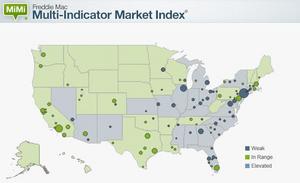Best Annual Improvement Since 2005
MCLEAN, VA--(Marketwired - Sep 23, 2015) - Freddie Mac (OTCQB : FMCC ) today released its updated Multi-Indicator Market Index® (MiMi®) showing the U.S. housing market continuing to slowly stabilize with one additional state, Rhode Island, and four additional metro areas entering their outer range of stable housing activity: Philadelphia and Harrisburg, Pennsylvania; Phoenix, Arizona; and Albany, New York.
The national MiMi value stands at 81, indicating a housing market that is on its outer range of stable housing activity, while showing an improvement of +0.93% from June to July and a three-month improvement of +2.99%. On a year-over-year basis, the national MiMi value has improved +6.17%. Since its all-time low in October 2010, the national MiMi has rebounded 37%, but remains significantly off from its high of 121.7.
News Facts:
Quote attributable to Freddie Mac Deputy Chief Economist Len Kiefer:
"Nationally, all MiMi indicators are heading in the right direction for the second consecutive month and improving more than 6 percent from the same time last year. Florida has some of the most improving housing markets in the country, largely a reflection of more borrowers becoming current on their mortgage payments as the local employment picture improves and house prices rebound. The one area of the country that has been slow to respond has been the Northeast. However, we've started to see these housing markets turn around, especially in Pennsylvania, Connecticut, New Hampshire, Vermont and Maine. While many of the locals markets in the Northeast are still weak, they're steadily trending in the right direction and their pace of improvement is accelerating. Overall, the West remains especially strong, with many markets posting double-digit growth in their MiMi purchase applications indicator compared to a year ago and helping to keep the country on pace for the best year of home sales since 2007."
The 2015 MiMi release calendar is available online.
MiMi monitors and measures the stability of the nation's housing market, as well as the housing markets of all 50 states, the District of Columbia, and the top 100 metro markets. MiMi combines proprietary Freddie Mac data with current local market data to assess where each single-family housing market is relative to its own long-term stable range by looking at home purchase applications, payment-to-income ratios (changes in home purchasing power based on house prices, mortgage rates and household income), proportion of on-time mortgage payments in each market, and the local employment picture. The four indicators are combined to create a composite MiMi value for each market. Monthly, MiMi uses this data to show, at a glance, where each market stands relative to its own stable range of housing activity. MiMi also indicates how each market is trending, whether it is moving closer to, or further away from, its stable range. A market can fall outside its stable range by being too weak to generate enough demand for a well-balanced housing market or by overheating to an unsustainable level of activity.
For more detail on MiMi see the FAQs. The most current version can be found at FreddieMac.com/mimi.
Freddie Mac was established by Congress in 1970 to provide liquidity, stability and affordability to the nation's residential mortgage markets. Freddie Mac supports communities across the nation by providing mortgage capital to lenders. Today Freddie Mac is making home possible for approximately one in four home borrowers and is one of the largest sources of financing for multifamily housing. Additional information is available at FreddieMac.com, Twitter @FreddieMac and Freddie Mac's blog FreddieMac.com/blog.

Comments